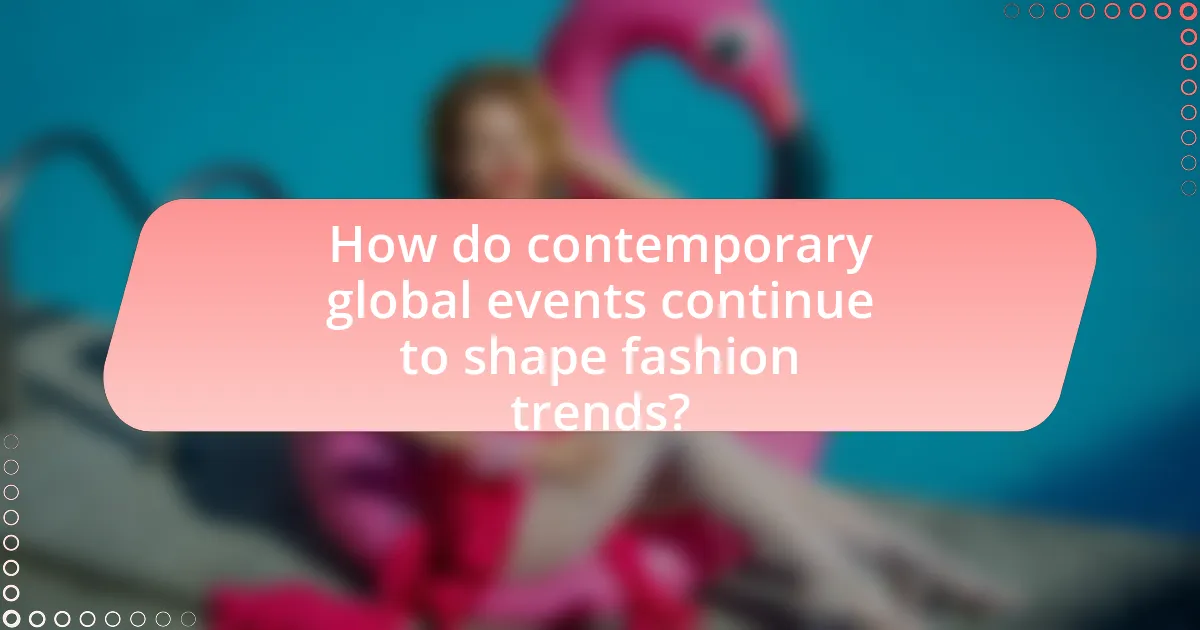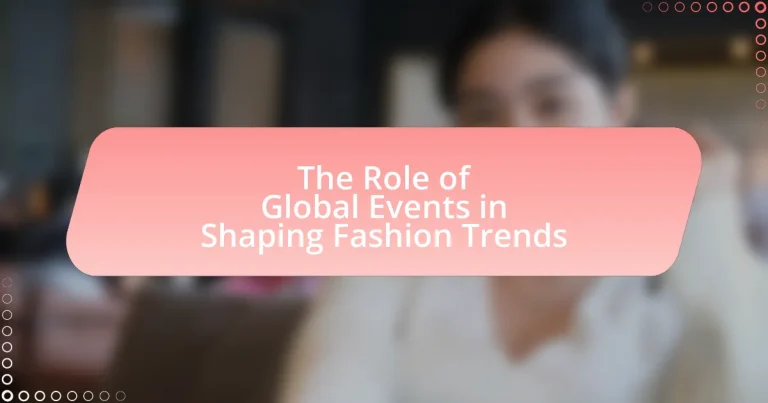The article examines the significant role of global events in shaping fashion trends, highlighting how these events influence consumer behavior, cultural exchanges, and industry practices. It discusses various types of global events, including economic crises, cultural movements, and social justice initiatives, and their impact on fashion choices and design aesthetics. Historical examples, such as World War II and the 1960s counterculture movement, illustrate how societal shifts have led to changes in fashion, while contemporary events like the COVID-19 pandemic and climate change awareness continue to drive trends towards comfort, sustainability, and inclusivity. The article emphasizes the importance for fashion designers and brands to understand these connections to remain relevant and responsive to evolving consumer expectations.

What is the Role of Global Events in Shaping Fashion Trends?
Global events play a significant role in shaping fashion trends by influencing consumer behavior, cultural exchanges, and industry practices. For instance, major events like the Olympics or international fashion weeks showcase diverse styles and innovations, prompting designers to adapt and create collections that reflect the zeitgeist. Additionally, global crises, such as the COVID-19 pandemic, have shifted fashion towards comfort and sustainability, as seen in the rise of athleisure and eco-friendly materials. Historical examples include the impact of World War II on fabric rationing, which led to the popularity of simpler, more functional designs. These events catalyze changes in fashion by altering societal values and priorities, thereby directly affecting what is produced and consumed in the fashion industry.
How do global events influence fashion trends?
Global events significantly influence fashion trends by altering consumer behavior, inspiring designers, and shifting cultural narratives. For instance, the COVID-19 pandemic led to a surge in demand for comfortable and functional clothing, as people prioritized loungewear and athleisure over formal attire. This shift was reflected in major fashion weeks, where brands showcased collections that emphasized comfort and versatility. Additionally, events like climate change awareness have prompted designers to adopt sustainable practices, leading to the rise of eco-friendly fashion lines. Historical examples include the impact of World War II on women’s fashion, where utility clothing became popular due to fabric rationing. These instances illustrate how global events can reshape the fashion landscape by influencing what consumers desire and how designers respond.
What types of global events have the most impact on fashion?
Global events that have the most impact on fashion include economic crises, cultural movements, technological advancements, and environmental disasters. Economic crises, such as the Great Depression, lead to shifts in consumer spending and preferences, often resulting in more practical and affordable fashion choices. Cultural movements, like the feminist movement of the 1960s, influence fashion by promoting gender equality and altering traditional gender roles in clothing. Technological advancements, such as the rise of social media, have transformed how fashion is marketed and consumed, enabling trends to spread rapidly. Environmental disasters, like climate change, have prompted a shift towards sustainable fashion practices, influencing designers to adopt eco-friendly materials and production methods. These events collectively shape consumer behavior and industry standards, demonstrating the interconnectedness of global occurrences and fashion evolution.
How do cultural shifts during global events affect fashion choices?
Cultural shifts during global events significantly influence fashion choices by altering societal values and priorities. For instance, during the COVID-19 pandemic, there was a marked shift towards comfort and practicality, leading to the rise of loungewear and athleisure as dominant trends. This change was driven by the necessity of remote work and social distancing, which prompted consumers to prioritize comfort over traditional formal attire. Additionally, global movements such as Black Lives Matter have led to increased awareness of diversity and representation in fashion, prompting brands to adopt more inclusive practices and promote diverse models. These examples illustrate how global events can reshape fashion by reflecting and responding to the evolving cultural landscape.
Why is it important to understand the connection between global events and fashion?
Understanding the connection between global events and fashion is crucial because it reveals how societal changes influence style and consumer behavior. For instance, the rise of social movements, such as the feminist movement in the 1960s, led to significant shifts in women’s fashion, promoting more practical and liberating clothing options. Additionally, events like economic downturns or pandemics can alter consumer priorities, as seen during the COVID-19 pandemic, which increased demand for comfortable and functional clothing. Recognizing these connections allows designers and brands to adapt their collections to reflect current societal sentiments, ensuring relevance and resonance with consumers.
What insights can be gained from analyzing this connection?
Analyzing the connection between global events and fashion trends reveals how societal shifts influence consumer behavior and design choices. For instance, the COVID-19 pandemic led to a surge in demand for comfortable and functional clothing, as evidenced by a 2020 report from McKinsey & Company, which noted a 40% increase in loungewear sales. This demonstrates that global events can directly impact fashion industry dynamics, shaping what consumers prioritize in their wardrobes. Additionally, events like climate change awareness have prompted brands to adopt sustainable practices, reflecting a growing consumer preference for eco-friendly products. Such insights highlight the importance of understanding external influences on fashion to anticipate market trends and consumer needs effectively.
How does this understanding benefit fashion designers and brands?
Understanding the role of global events in shaping fashion trends benefits fashion designers and brands by enabling them to anticipate consumer preferences and align their collections with current societal sentiments. This alignment can lead to increased relevance in the market, as designers who incorporate themes from significant global events often resonate more with consumers, driving sales and brand loyalty. For instance, brands that embraced sustainability during the climate change movement saw a notable rise in consumer engagement, as evidenced by a 2021 McKinsey report indicating that 67% of consumers consider sustainability when making a purchase. Thus, leveraging insights from global events allows fashion entities to create timely, impactful designs that meet evolving consumer expectations.

What are some historical examples of global events shaping fashion trends?
Global events have significantly shaped fashion trends throughout history, with notable examples including World War II, the 1960s counterculture movement, and the COVID-19 pandemic. During World War II, fabric rationing led to the popularity of simpler, more practical clothing styles, such as the utility dress in Britain, which emphasized functionality over extravagance. The 1960s counterculture movement introduced bold colors, psychedelic patterns, and unisex clothing, reflecting social upheaval and a desire for freedom and self-expression. The COVID-19 pandemic shifted fashion towards comfort and practicality, resulting in the rise of loungewear and athleisure as people prioritized comfort while working from home. These events illustrate how societal changes and global crises can directly influence fashion trends, adapting to the needs and sentiments of the time.
How did World War II influence fashion design and trends?
World War II significantly influenced fashion design and trends by introducing practicality and functionality into clothing. The war necessitated the use of rationing, which led to the simplification of designs, prioritizing utility over extravagance. For instance, the introduction of the “make do and mend” campaign encouraged women to repurpose and repair existing garments rather than buy new ones, fostering a culture of resourcefulness in fashion. Additionally, military styles became prominent, with elements such as tailored jackets and structured silhouettes being adopted in civilian clothing. The impact of wartime fabric shortages also led to the use of alternative materials, such as synthetic fibers, which later became staples in fashion. This shift towards practicality and the incorporation of military aesthetics laid the groundwork for post-war fashion movements, including the rise of the New Look by Christian Dior in 1947, which emphasized femininity while still reflecting the utilitarian influences of the war era.
What specific changes occurred in women’s fashion during this period?
During this period, women’s fashion underwent significant changes characterized by a shift towards more practical and comfortable clothing. The influence of global events, such as World War II, led to the adoption of utilitarian styles, including shorter hemlines and the introduction of trousers for women, reflecting the need for functionality in daily life. Additionally, the post-war era saw the emergence of the New Look in the late 1940s, popularized by designer Christian Dior, which emphasized femininity through cinched waists and full skirts, marking a return to more traditional feminine silhouettes after years of wartime austerity. These changes illustrate how global events directly impacted women’s fashion choices, balancing practicality with evolving societal norms.
How did wartime rationing affect fabric choices and styles?
Wartime rationing significantly influenced fabric choices and styles by limiting the availability of materials and promoting resourcefulness in design. During World War II, governments imposed restrictions on textiles, leading to a scarcity of luxury fabrics like silk and wool, which were often repurposed for military use. This scarcity resulted in the increased popularity of utilitarian fabrics such as cotton and rayon, which were more readily available and affordable. Additionally, fashion styles shifted towards simpler, more functional designs that required less fabric, exemplified by the introduction of the “make do and mend” ethos, encouraging consumers to repair and repurpose existing clothing. Historical evidence shows that in the UK, the Utility Clothing Scheme was established in 1941, which regulated the amount of fabric used in garments, further solidifying the trend towards minimalism and practicality in wartime fashion.
What role did the 1960s counterculture movement play in fashion evolution?
The 1960s counterculture movement significantly influenced fashion evolution by promoting individuality and rejecting mainstream norms. This movement, characterized by anti-establishment sentiments, led to the rise of styles such as tie-dye, bell-bottoms, and psychedelic prints, which symbolized freedom and self-expression. The use of unconventional materials and the embrace of vintage clothing reflected a departure from traditional fashion standards. Events like the Summer of Love in 1967 and the Woodstock Festival in 1969 showcased these trends, solidifying their impact on popular culture. The counterculture’s emphasis on personal style and social statements reshaped the fashion landscape, making it more inclusive and diverse.
How did music festivals and protests influence clothing styles?
Music festivals and protests significantly influenced clothing styles by promoting self-expression and social messages through fashion. Events like Woodstock in 1969 popularized bohemian styles, characterized by tie-dye, fringe, and vintage clothing, reflecting the counterculture movement. Similarly, protests such as the Civil Rights Movement and the Women’s Liberation Movement introduced utilitarian and statement pieces, like the black beret and protest t-shirts, which became symbols of activism. These events not only shaped individual fashion choices but also led to broader trends in mainstream fashion, as designers began to incorporate elements from these cultural movements into their collections, demonstrating the powerful intersection of social movements and style.
What lasting impacts did this era have on modern fashion trends?
The era significantly influenced modern fashion trends by introducing concepts of casual wear and gender fluidity. The rise of streetwear during this period, characterized by comfortable and practical clothing, laid the foundation for contemporary fashion that prioritizes both style and comfort. Additionally, the blending of traditionally gendered clothing, such as skirts for men and unisex styles, emerged from this era, promoting inclusivity and challenging societal norms. This shift is evidenced by the ongoing popularity of brands that embrace these principles, such as Off-White and Balenciaga, which continue to reflect the era’s impact on today’s fashion landscape.

How do contemporary global events continue to shape fashion trends?
Contemporary global events significantly shape fashion trends by influencing consumer behavior, design aesthetics, and cultural narratives. For instance, the COVID-19 pandemic led to a surge in demand for comfortable and functional clothing, as people prioritized loungewear and athleisure over formal attire. This shift is evidenced by a 2020 report from McKinsey & Company, which noted that 67% of consumers were purchasing more casual clothing during lockdowns. Additionally, social movements such as Black Lives Matter have prompted brands to adopt more inclusive and diverse representations in their marketing and product offerings, reflecting a growing consumer expectation for social responsibility. This trend is supported by a 2021 survey from Fashion Revolution, which found that 79% of consumers believe brands should be more transparent about their practices. Thus, contemporary global events directly influence fashion trends by altering consumer preferences and prompting brands to adapt their strategies accordingly.
What recent global events have influenced fashion in the 21st century?
Recent global events that have influenced fashion in the 21st century include the COVID-19 pandemic, climate change awareness, and social justice movements. The COVID-19 pandemic led to a surge in loungewear and athleisure as people prioritized comfort while working from home. Climate change awareness has prompted the fashion industry to adopt sustainable practices, with brands increasingly focusing on eco-friendly materials and ethical production methods. Social justice movements, particularly the Black Lives Matter movement, have influenced fashion by promoting diversity and inclusivity, leading to greater representation of marginalized communities in fashion campaigns and runway shows. These events have collectively reshaped consumer preferences and industry standards, driving significant changes in fashion trends.
How did the COVID-19 pandemic alter fashion consumption and trends?
The COVID-19 pandemic significantly altered fashion consumption and trends by accelerating the shift towards casual and comfortable clothing. As lockdowns and remote work became prevalent, consumers prioritized comfort over style, leading to increased demand for loungewear and athleisure. According to a report by McKinsey & Company, 67% of consumers stated they were more likely to wear comfortable clothing during the pandemic, which resulted in a decline in formal wear sales. Additionally, the rise of e-commerce became pronounced, with online shopping surging by 30% in 2020, as physical stores faced closures. This shift not only changed purchasing habits but also influenced brands to adapt their marketing strategies, focusing more on digital engagement and sustainability.
What role do social movements play in current fashion trends?
Social movements significantly influence current fashion trends by promoting awareness and driving change in consumer behavior and brand practices. For instance, movements advocating for sustainability have led to a rise in eco-friendly fashion brands and practices, as seen in the increased popularity of materials like organic cotton and recycled fabrics. Additionally, social justice movements, such as Black Lives Matter, have prompted brands to address diversity and representation in their marketing and product offerings, resulting in more inclusive fashion lines. This shift is supported by data indicating that 66% of consumers are willing to pay more for sustainable brands, highlighting the impact of social movements on purchasing decisions and industry standards.
How can fashion brands adapt to changes brought by global events?
Fashion brands can adapt to changes brought by global events by implementing agile supply chain strategies and embracing digital transformation. Agile supply chains allow brands to quickly respond to disruptions, such as those caused by pandemics or geopolitical tensions, ensuring that production and distribution can pivot as needed. For instance, during the COVID-19 pandemic, many fashion brands shifted to producing personal protective equipment, demonstrating flexibility in their operations. Additionally, digital transformation, including e-commerce and virtual fashion shows, enables brands to reach consumers directly and maintain engagement despite physical retail challenges. According to McKinsey’s “The State of Fashion 2021” report, 70% of fashion executives indicated that digital acceleration was a key priority for their companies in response to global disruptions.
What strategies can brands implement to stay relevant during global shifts?
Brands can implement adaptive marketing strategies to stay relevant during global shifts. This includes leveraging real-time data analytics to understand changing consumer behaviors and preferences, allowing brands to pivot their messaging and product offerings accordingly. For instance, during the COVID-19 pandemic, many fashion brands shifted focus to comfortable and casual wear, reflecting the increased demand for loungewear as people spent more time at home. Additionally, brands can engage in social responsibility initiatives that resonate with current global issues, such as sustainability and inclusivity, which have become increasingly important to consumers. Research from McKinsey & Company indicates that brands demonstrating a commitment to social values can enhance customer loyalty and brand perception during times of crisis.
How can brands leverage social media to respond to global events?
Brands can leverage social media to respond to global events by creating timely and relevant content that resonates with their audience. This approach allows brands to engage in real-time conversations, showcase their values, and demonstrate social responsibility. For instance, during the COVID-19 pandemic, many fashion brands utilized social media to promote health guidelines, share stories of community support, and pivot their production to create masks, which not only addressed a pressing global issue but also aligned with consumer expectations for corporate accountability. This strategy enhances brand loyalty and fosters a sense of community among consumers, as evidenced by increased engagement metrics during such campaigns.
What are best practices for fashion designers in responding to global events?
Fashion designers should prioritize adaptability, cultural sensitivity, and sustainability when responding to global events. Adaptability allows designers to quickly shift their collections and messaging to align with current events, ensuring relevance and resonance with consumers. Cultural sensitivity is crucial, as designers must be aware of the social and political implications of their work, particularly in times of crisis, to avoid misrepresentation or insensitivity. Sustainability practices should be emphasized, as global events often highlight environmental concerns, prompting designers to adopt eco-friendly materials and ethical production methods. For instance, during the COVID-19 pandemic, many designers pivoted to producing masks and healthcare apparel, demonstrating adaptability while addressing urgent needs.


